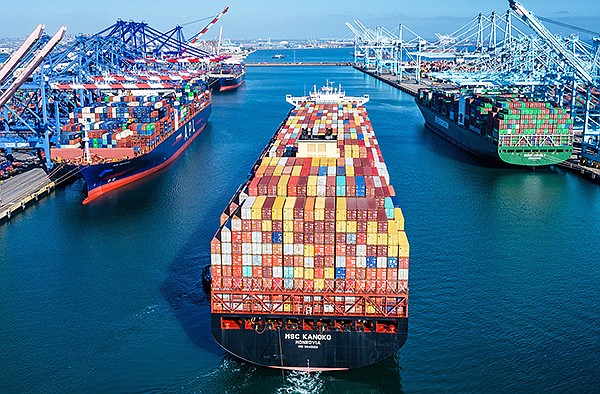More than half of the budget will be devoted to increasing goods-movement capacity as well as zero-emission modernization projects. | Photo courtesy of Port of Los Angeles
IMPORT/EXPORT
California Governor Signs Off on Unprecedented Port-Budget Package
Relief may be coming for frustrated apparel makers tired of waiting while their goods are stuck on a ship unable to dock.
In the state budget for the upcoming fiscal year, California Gov. Gavin Newsom signed off on an unprecedented $2.3 billion for port infrastructure improvements and upgrades, including $110 million for the creation of a Goods Movement Training Campus at the San Pedro Bay port complex.
“Continual investment in port infrastructure, sustainable technologies and jobs creation is essential to maintaining our competitiveness now and in the future,” said Port of Los Angeles Executive Director Gene Seroka in an announcement following the budget signing. “Workforce development is an equally critical component of the goods-movement sector, and we are thrilled to have the governor’s support of our initiative to create the nation’s first training campus.”
The Goods Movement Training Campus will focus on upskilling and reskilling port workforces to address the rapidly changing needs of the logistics industry. “The unprecedented supply-chain challenges of the past two years have underscored the need to invest in new technology and training at our ports to keep goods moving reliably, efficiently and safely,” said Jim McKenna, president and CEO of the Pacific Maritime Association.
The governor’s $2.3 billion plan for ports also includes:
• $1.2 billion for port-related projects that increase goods-movement capacity on rail- and roadways serving ports and at port terminals, including railyard expansions, new bridges and zero-emission modernization projects.
• $760 million for zero-emission equipment and vehicles, including human-operated zero-emission port equipment, short-haul (drayage) trucks and infrastructure.
• $30 million to be used by the governor’s Office of Business and Economic Development to fund operational and process improvements at ports. Grants will focus on enhancing goods movement, reducing congestion, improving data interconnectivity between ports, and creating opportunities to increase cargo volumes by promoting and building supply-chain efficiencies.
• $40 million to enhance California’s capacity to issue commercial driver’s licenses, allowing for more truck drivers to serve the San Pedro Bay port complex.
The Port of Los Angeles is the busiest seaport in the Western Hemisphere. In 2021 it facilitated 10.7 million container units valued at $294 billion in trade.






















